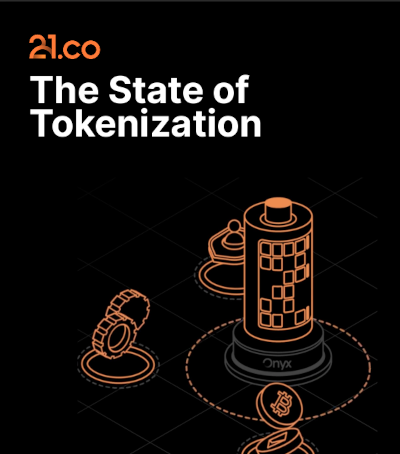Introduction
The world of cryptocurrencies and blockchain technology has been evolving rapidly over the past few years. One of the most exciting developments in this space is the emergence of tokenization, which has the potential to transform the way we think about ownership, investment, and value exchange.
In this blog post, we will explore the key elements of the State of Tokenization report by 21.co, which provides an in-depth analysis of the current state and future prospects of tokenization. We will summarize each chapter of the report, highlighting the main key points and insights.
By the end of this post, you will have a comprehensive understanding of the opportunities and challenges of tokenization, and how it is likely to shape the future of finance and beyond.
Executive Summary
The report identifies tokenization as a major trend in the blockchain and cryptocurrency space, with the potential to unlock trillions of dollars in value across a wide range of asset classes. It also identifies several challenges and regulatory issues that need to be addressed in order to fully realize the potential of tokenization. These include issues related to security, liquidity, and compliance.
Blockchains and Distributed Ledger Technologies (DLTs)
This chapter provides an overview of the underlying technologies that enable tokenization, including blockchains and distributed ledger technologies (DLTs). Ethereum and Tron have the lion’s share of tokenized assets as of October 2023, primarily due to the amount of stablecoins issued on each network.
Regarding the market share, Ethereum remains the digital asset industry’s financial hub, with over 50% of all tokenized fiat currencies.

Tokenized Assets
Tokenized assets are digital representations of real-world assets such as stocks, bonds, and real estate. Tokenization enables fractional ownership and transferability of these assets, which can unlock new investment opportunities and increase liquidity.
Different types of tokenized assets are security tokens, utility tokens, and non-fungible tokens (NFTs).
The potential of tokenized assets is to democratize access to investment opportunities and unlock new sources of value.
Trading Venues
Different types of trading venues that enable the exchange of tokenized assets, including centralized exchanges, decentralized exchanges, and peer-to-peer marketplaces. These venues are affected by regulatory ambiguities and inadequate shared infrastructure, even if they enable liquidity and price discovery for tokenized assets. Different regulatory frameworks are applied to these venues, and the challenges of ensuring security and compliance are high.

Investor Demographics
There were about 431 million crypto users globally at the beginning of 2023, representing ~5.36% of the world population. Tokenization can enable access to investment opportunities for a wider range of investors, including retail investors and those in emerging markets. Different types of investors interested in tokenized assets includes institutional investors, family offices, and high-net-worth individuals. The chapter concludes by highlighting the potential of tokenization to democratize access to investment opportunities and increase financial inclusion.
Developers and entrepreneurs are the first adopters of blockchain technology and an
early indicator of potential value creation. Blockchain developers represent only the 0.1% of all the category.
Excluding stablecoins, there are about 116k holders of tokenized assets as of October 2023.
Based on Carlota Perez’s framework, crypto is transitioning from frenzy to synergy.

Total Addressable Market and Future Prospects
This chapter explores the potential size of the market for tokenized assets, and the factors that are likely to drive growth in this market. Tokenization can unlock trillions of dollars in value across a wide range of asset classes, including real estate, art, and intellectual property. Different use cases for tokenization beyond traditional asset classes, are loyalty points, carbon credits, and gaming assets.
Tokenization can transform the way we think about ownership, investment, and value exchange. The report estimates that the market value for tokenized assets will be between $3.5 trillion in a bear-case scenario and $10 trillion in a bull-case scenario by 2030.
Challenges and Regulations
Security, liquidity, and compliance are major concerns for investors and regulators alike. Different regulatory frameworks apply to tokenized assets, including securities laws, anti-money laundering (AML) regulations, and tax laws. This is a call for collaboration between industry stakeholders and regulators to ensure the safe and responsible development of tokenization.
Conclusion
In conclusion, the State of Tokenization report provides a comprehensive analysis of the current state and future prospects of tokenization. The report highlights the potential of tokenization to transform the way we think about ownership, investment, and value exchange, and identifies several challenges and regulatory issues that need to be addressed in order to fully realize this potential.
By exploring the different chapters of the report, we have gained a deeper understanding of the underlying technologies that enable tokenization, the different types of tokenized assets and trading venues, the demographics of investors who are interested in tokenized assets, the potential size of the market for tokenized assets, and the challenges and regulatory issues that need to be addressed.
Overall, the report paints a picture of a rapidly evolving ecosystem that is likely to play a major role in the future of finance and beyond.
While there are certainly challenges and regulatory issues that need to be addressed, the potential benefits of tokenization are too great to ignore. As such, it is important for industry stakeholders and regulators to work together to ensure the safe and responsible development of tokenization.
In conclusion, the State of Tokenization report provides a valuable resource for anyone interested in understanding the opportunities and challenges of tokenization.

Leave a Reply